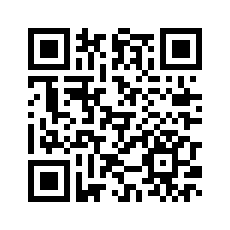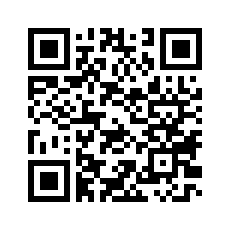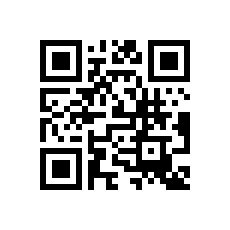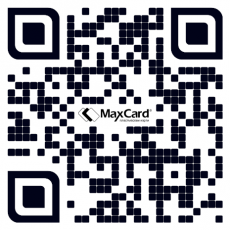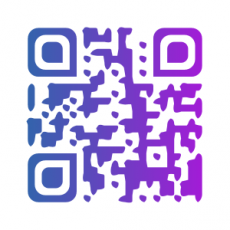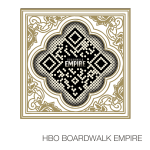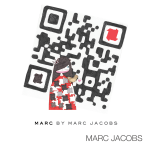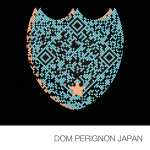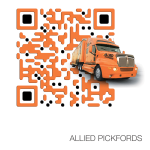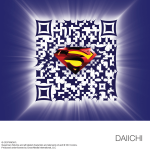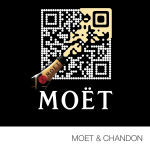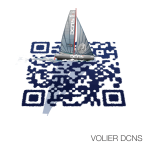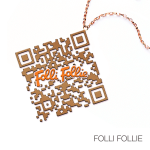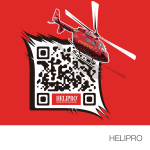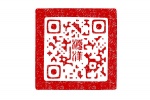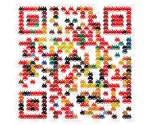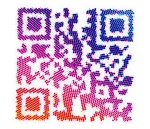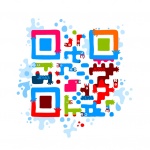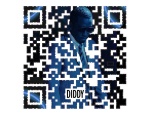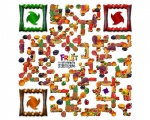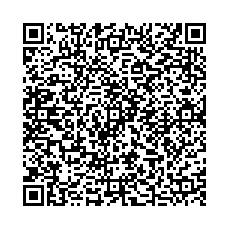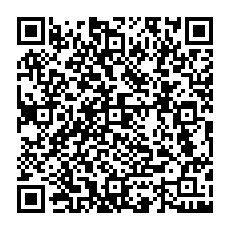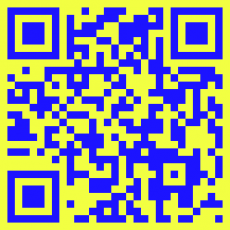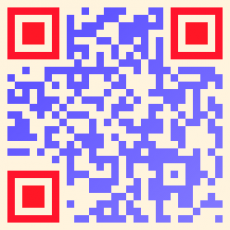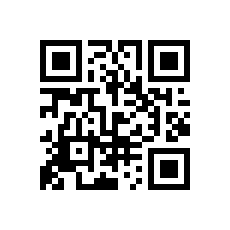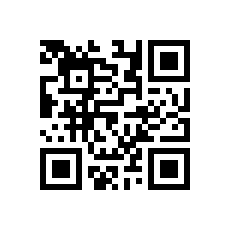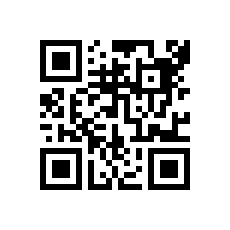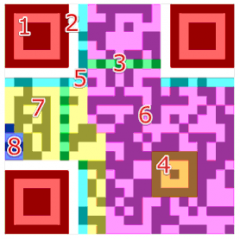Difference between revisions of "QR CODE"
(→Does a QR Code Have To Be Black And White?) |
(→Can a QR Code Be Rotated?) |
||
| Line 142: | Line 142: | ||
== Can a QR Code Be Rotated? == | == Can a QR Code Be Rotated? == | ||
| − | + | Yes, A QR Code is omnidirectional and can be viewed / scanned any way around. Position detection patterns (Finder Patterns) help the scanner identify the correct way to read the image. This example is the same code in different rotated angles. | |
<gallery widths=230px heights=230px > | <gallery widths=230px heights=230px > | ||
| Line 154: | Line 154: | ||
Всеки QR Code има 3 модела за откриване на позиция, които могат да се разглеждат като големи квадратни рамки с по-малък плътен квадрат в тях. Те са разположени в трите края на QR кода. Четвъртия ъгъл не разполага с модел за откриване на позиция, вместо това има модел за подравняване. Този модел за подравняване позволява на скенера да определи правилната позиция за обработка на изображението (модела заподравняване винаги е в долния десен ъгъл). Това позволява на скенера ефективно да отмени всякакво завъртане. | Всеки QR Code има 3 модела за откриване на позиция, които могат да се разглеждат като големи квадратни рамки с по-малък плътен квадрат в тях. Те са разположени в трите края на QR кода. Четвъртия ъгъл не разполага с модел за откриване на позиция, вместо това има модел за подравняване. Този модел за подравняване позволява на скенера да определи правилната позиция за обработка на изображението (модела заподравняване винаги е в долния десен ъгъл). Това позволява на скенера ефективно да отмени всякакво завъртане. | ||
| − | |||
== How Secure is a QR Code? == | == How Secure is a QR Code? == | ||
Revision as of 11:46, 7 October 2015
Contents
- 1 What's A QR Code?
- 2 Make Your Own QR Code
- 3 Some Examples Of QR Codes
- 4 QR Code Design
- 5 How Much Data Can A QR Code Store?
- 6 How Many Characters / Digits Can A QR Code Store?
- 7 Does a QR Code Have To Be Black And White?
- 8 Can QR Codes Be Inverted Or Mirrored?
- 9 Can a QR Code Be Rotated?
- 10 How Secure is a QR Code?
- 11 What Are The Different Sections In A QR Code?
- 12 QR Code Error Correction
What's A QR Code?
They are barcodes, very similar to the barcodes you’ve seen on almost every product you've bought. The main different between QR Codes and traditional barcodes, is that QR Codes can store many times more data in a much smaller area due to their ability to store data in 2 dimensions rather than 1. To name a few of QR Codes benifts:
- High Capacity - Require Less Space - Dirst And Damage Resistant - Readable From Any Direction
They started out very popular in the East but over the last 3 years have become ever more popular worldwide, this has been driven mainly by the fact they are so easy to scan as well as create. QR Codes are popping up everywhere and today they can be found in magazines, newspapers, product packaging and billboards. They are flexible, very cheap to create and the scope of use is very large. The purpose of a QR Code is to quickly and easily get data from a printed medium to a digital medium such as your smartphone. Compatibility is key to their rising popularity.
Make Your Own QR Code
The QR Code generator in the link below has been created by the Zxing project and is free to use via their website.
Please take the time to visit their homepage
Some Examples Of QR Codes
QR Codes hold many different types of data, with the naked eye you can’t tell what type of data a QR Code holds.QR Code scanner will process data differently based on its data type. This page contains examples of some of the more common data types which you can test on your Smartphone. You will notice that the different types of data behave in different ways. For example if the code contains a URL, the scanner is able to launch your browser with that URL, if it contains contact details then it can save them directly to your address book. This versatility offers a variety of uses for QR Codes.
- Some Examples Of QR Codes
QR Code Design
When you're creating a QR Code, you don't just have a grid of black and white squares to work with. You can use multiple colours and can also take advantage of error correction techniques built into the specification to embed images. Making your QR Code original, ensures that of the millions of QR Codes out there, people notice and take the time to scan yours. The reason images and logos can be displayed within QR Codes is mainly down to the built in error correction. The error correction allows up to 30% of a QR Codes to be corrupt while still remaining readable to a barcode reader. This means that you can use up to 30% of the QR Codes surface area to include your logo and designs.
- QR Code Design
- Samples
How Much Data Can A QR Code Store?
Unlike traditional barcodes, QR Codes are 2 dimensional allowing them to store a lot more data. The maximum amount of data a QR Code can store is 3Kb. A QR Code is made of up multiple rows and columns. These are seen by the naked eye as small squares, the combination of 177 columns and rows allows for a total of 31,329 squares. It's the arrangement of those squares in varying configurations that are able to store the data.
There are not 31,329 squares in every code. When a code is being created the generator determines the amount of data it needs to store and therefore the number of rows and columns needed to encode that data. If a QR Code contains more data, then you will generally find that it looks more dense(more squares and smaller squares). Similarly, turning on Error Correction within a QR Code increases the amount of data stored in a code and therefore the density. Here are some examples:
In addition to storing the intended content of the QR Code, the code must also store positioning, timing, alignment, format, error correct and version data to ensure it can be read easily by a wide range of scanners. Thankfully this is all built into the design of the QR Code and its only error correction that will subtract from the available 3Kb. It’s a common misconception that adjusting the surface area of a code will allow you to include more data. This isn’t true as increasing the surface area of your code will not allow you to have more than 177 columns and rows and so simply stretches the code.
How Many Characters / Digits Can A QR Code Store?
So we know that QR Codes store data up to 3Kb, but how does that translate into characters such as digits or text? When a QR Code is created, the user chose the encoding that is to be used and sets the type of data that the code will store. The chosen data type and encoding has a big impact on the number of characters that can be stored. As an example, if you were to create a QR Code that was only to contain alphanumeric data, then you would have the ability to encode up to 4296 characters.
| Numeric Only | Maximum 7089 characters |
| Alphanumeric | Maximum 4296 characters |
| Binary(8 bits) | Maximum 2953 bytes |
If you were to create a QR Code that would store binary data, then the number of characters you could store would reduce to 2953 as a result of the different type of encoding that would be used. This table details the maximum amount of data for each data type. These figures do assume that you’re able to use up all 3Kb of available space within your code, once you start to enable error correction at its various levels, it can reduce that amount of data that can be stored by up to 30%.
Does a QR Code Have To Be Black And White?
Although most QR Codes are black and while, they don't necessarily have to be this way. A QR Code can be any colour and can even include more than 2 different colours. There's examples of coloured QR Codes below.
Each QR Code is made of 2 types of small squares. This is most visible when looking at a black and while QR Code where squares are either black or white. For the purposes of this explanation, let’s call the black squares "foreground squares" and the white squares "background squares". While the image uses a variety of colours in order to stand out, it also ensures that all the colours used on the foreground squares are easily distinguishable from those used on the background squares. This means that your barcode reader won’t have any difficulty in picking up the foreground and background squares. Just by adding colour and a bit of design, designers have created some very interesting QR Codes.
Can QR Codes Be Inverted Or Mirrored?
One of the most common questions asked about QR Codes is can they be rotated or mirrored and still work. In short the answer is No. Mirroring a QR Codes or inverting it will prevent barcode readers from being able to decode the image and pull the data from within.
Can a QR Code Be Rotated?
Yes, A QR Code is omnidirectional and can be viewed / scanned any way around. Position detection patterns (Finder Patterns) help the scanner identify the correct way to read the image. This example is the same code in different rotated angles.
Всеки QR Code има 3 модела за откриване на позиция, които могат да се разглеждат като големи квадратни рамки с по-малък плътен квадрат в тях. Те са разположени в трите края на QR кода. Четвъртия ъгъл не разполага с модел за откриване на позиция, вместо това има модел за подравняване. Този модел за подравняване позволява на скенера да определи правилната позиция за обработка на изображението (модела заподравняване винаги е в долния десен ъгъл). Това позволява на скенера ефективно да отмени всякакво завъртане.
How Secure is a QR Code?
Предвид това калко основен и опростен е един QR Код би могло да се предположи, че няма риск за сигурността на потребителя. Но има някои области, в които QR кодът може да представляват риск за вашата сигурност и безопасност. QR кодове са малки безвредни модели отпечатани върху повърхност (билборд, плакат и т.н.) и целта им е само да ви помогнат да получите данни от печатна информация в цифров носител. Те не могат лесно да се четат с невъоръжено око, така че е особено трудно да се манипулират след отпечатването им. Предвид, че тяхната употреба е най-вече за да се предоставят удобно на потребителя малки откъси от информация се предполага, че никой не би се интересувал от тях да ги променя или прави опасни. Но има няколко причини и неща, които трябва да се имат в предвид. Първата и най-вероятно основната причина ще бъде така наречения - фишинг. Фишингът не е ограничен само до имейли, вируси или троянски коне. В действителност с помощта на QR кодове, нищо неподозиращите потребители могат да бъдат насочени към опасни адреси в интернет и др. Данни за контакт в рамките на код могат да бъдат променени така, че да предизвика потребителите да се обадят или изпратят СМС на платен номер.
What Are The Different Sections In A QR Code?
QR кодовете са разделени на различни секции и скенерите използват тези секции за декодиране на данните. По-долу е описана всяка секция. Изображението по-долу е стандартен текст базиран QR Код. Ако сканирате кода трябва да се декодира като текст и просто ще включва текста "Sample QR Code".
- Раздел 1 – Модул за откриване на позиция - състои се от три идентични структури, които се намират във трите ъгъла на QR кода, с изключение на долния десен ъгъл. Всеки модел се основава на 3x3 матрица от черни модули, заобиколени от бели модули, заобиколени от черни модули. Моделите за откриване на позиция позволяват софтуера да разпознае QR кода и да определи правилната му ориентация.
- Раздел 2 – Разделители - Бели сепаратори с ширина от един пиксел служат за подобряване на разпознаваемост на Моделите за откриване на позиция, отделяйки ги от действителните данни. Те обикновено са бели
- Раздел 3 – Синхронизиращ модул -редуващите се черни и бели квадрати в синхронизиращия модул дават възможност на софтуера да определи ширината на един модул.
- Раздел 4 – Подравняващ модул - помага на софтуера да компенсира умерени изкривявания на изображението . С нарастването на размера на кода, се добавят нови Подравняващи модули.
- Раздел 5 – Формат на информацията - състои се от 15 бита до сепараторите и съхранява информация за нивото на корекция на грешката на QR кода и избрания модел на маскиране.
- Раздел 6 – Данни - данните се конвертират в битов поток и след това се съхраняват в 8-битови части (наречени кодови думи) в раздела за данни.
- Раздел 7 – Корекция на грешките - подобно на секцията за данни, кодовете за коригиране на грешки се съхраняват в дълги 8 бита части в раздела за отстраняване на грешки.
- Раздел 8 – Остатъчни битове – тази секция се състои от празни битове в случай, че Данните и Корекцията на грешки не могат да бъдат разделени в 8-битови кодови думи без остатък.
QR Code Error Correction
Корекцията на грешки може да гарантира, че QR Кода остава четим, когато до 30% от него е корумпиран.Корекцията на грешки не винаги е включена. Когато един код се генерира потребителя решава дали иска корекцията на грешки да бъде включена. Има 4 различни настройки за корекция на грешките. Колкото е по-високо нивото на коригиране на грешки в кода остава по-малко пространство за съхранение на данни.Има случаи, когато корекцията на грешки си струва да жертвате пространството за съхранение и случаи, когато това не е така. За пример е визитната картичка, където най-вероятно не е нужно да съхранявате много подробности, но картата може да се повреди или намокри, преди получателят да е имал възможност да сканира кода. От друга страна, ако се създаде код, който ще бъде показван само цифрово(това е малко вероятно) съдържанието на кода няма как да се повреди и не е необходимо коригиране на грешки. Както споменахме по рано има 4 различни нива на корекция на грешката. Това са: L (до 7% щети) M (до 15% щети) Q (до 25% увреждане) H (до 30% щети). Корекцията на грешки се постига с помощта на "Reed-Solomon Error Correction" Това е математически алгоритъм за бекъп на съхранената информация.



